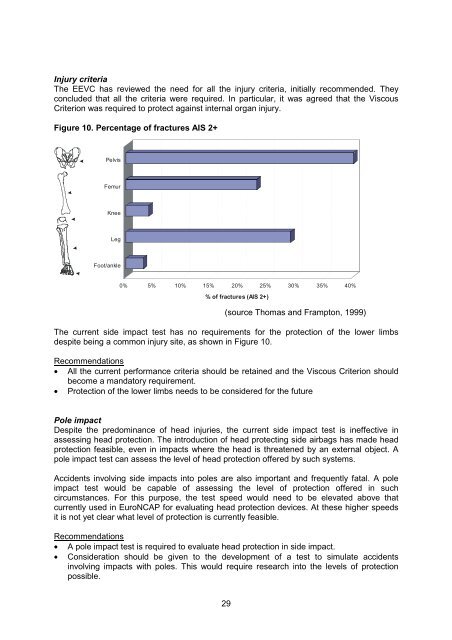PRIORITIES FOR EU MOTOR VEHICLE SAFETY DESIGN
priorities for eu motor vehicle safety design - ETSC
priorities for eu motor vehicle safety design - ETSC
Create successful ePaper yourself
Turn your PDF publications into a flip-book with our unique Google optimized e-Paper software.
Injury criteria<br />
The EEVC has reviewed the need for all the injury criteria, initially recommended. They<br />
concluded that all the criteria were required. In particular, it was agreed that the Viscous<br />
Criterion was required to protect against internal organ injury.<br />
Figure 10. Percentage of fractures AIS 2+<br />
Pelvis<br />
Femur<br />
Knee<br />
Leg<br />
Foot/ankle<br />
0% 5% 10% 15% 20% 25% 30% 35% 40%<br />
% of fractures (AIS 2+)<br />
(source Thomas and Frampton, 1999)<br />
The current side impact test has no requirements for the protection of the lower limbs<br />
despite being a common injury site, as shown in Figure 10.<br />
Recommendations<br />
• All the current performance criteria should be retained and the Viscous Criterion should<br />
become a mandatory requirement.<br />
• Protection of the lower limbs needs to be considered for the future<br />
Pole impact<br />
Despite the predominance of head injuries, the current side impact test is ineffective in<br />
assessing head protection. The introduction of head protecting side airbags has made head<br />
protection feasible, even in impacts where the head is threatened by an external object. A<br />
pole impact test can assess the level of head protection offered by such systems.<br />
Accidents involving side impacts into poles are also important and frequently fatal. A pole<br />
impact test would be capable of assessing the level of protection offered in such<br />
circumstances. For this purpose, the test speed would need to be elevated above that<br />
currently used in EuroNCAP for evaluating head protection devices. At these higher speeds<br />
it is not yet clear what level of protection is currently feasible.<br />
Recommendations<br />
• A pole impact test is required to evaluate head protection in side impact.<br />
• Consideration should be given to the development of a test to simulate accidents<br />
involving impacts with poles. This would require research into the levels of protection<br />
possible.<br />
29



